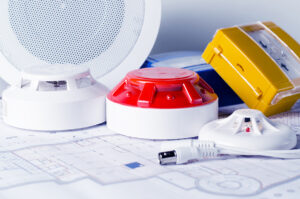
Fire safety is taken to the next level with integrated alarms and sprinkler systems.
Fire safety is a critical component of any commercial building, as it protects lives, property, and business continuity. With complex structures and high occupancy rates, commercial buildings face significant fire risks, making a robust fire protection system essential. Integrated alarms and sprinkler systems play a pivotal role in this protective infrastructure. When combined, these systems not only detect fires quickly but also actively suppress them, drastically reducing potential damage.
Understanding Integrated Alarms and Sprinklers
When it comes to fire protection, alarms and sprinklers are two of the most vital components. Fire alarms are designed to detect smoke, heat, or flames, then immediately alert building occupants to evacuate. These systems can be as simple as manual alarms activated by a pull station or as complex as automatic systems that trigger upon detecting heat or smoke. Meanwhile, sprinkler systems are built to control or extinguish fires by releasing water when specific heat conditions are met. By preventing the spread of flames, they allow people to evacuate safely and help contain property damage.
Integrated systems are designed to work in tandem. When an alarm detects a fire, it can trigger the sprinklers to activate in the affected areas, providing a dual response that combines early warning and direct fire suppression. This integration not only speeds up the reaction time but also enhances the efficiency of the entire fire protection system. It’s a synchronized response to fire threats that can make a significant difference in outcomes.
Best Practices for Integrated Fire Safety Systems
Ensuring that integrated alarms and sprinklers function as intended is crucial for maintaining fire safety. Here are some best practices for achieving this:
- Regular Testing and Maintenance: Testing and maintenance are essential for any fire protection system. Alarms and sprinklers should be tested regularly according to local fire codes and manufacturers’ guidelines. Routine inspections can catch issues such as clogged sprinkler heads, dead batteries in alarms, or faulty wiring before they become critical.
- Staff Training and Fire Drills: Training employees to understand the fire safety protocols, evacuation routes, and the function of alarms and sprinklers can make a significant difference in an emergency. Regular fire drills ensure that employees know how to respond if an alarm is triggered, which minimizes panic and speeds up the evacuation process.
- Collaborate with a Certified Fire Safety Professional: Installing and maintaining integrated fire safety systems requires expertise, so it’s wise to collaborate with a certified fire safety professional. These experts understand local fire codes and can help customize a system that meets the building’s specific needs while ensuring optimal functionality.
- Integrate with Modern Building Automation Systems: Many modern commercial buildings utilize Building Automation Systems (BAS) to manage HVAC, lighting, and security. By integrating alarms and sprinklers into these systems, building managers gain a centralized view of fire safety data, allowing for quick, informed decision-making during emergencies.
- Stay Updated with Fire Codes and Technology Advancements: Fire safety regulations and technologies are constantly evolving, so staying informed is essential. This includes upgrading to newer fire detection or suppression systems when appropriate and ensuring that any changes to building occupancy or layout are reflected in the fire safety plan.
TRUST THE PROFESSIONALS AT ARK SYSTEMS
Located in Columbia, Maryland, ARK Systems provides unsurpassed quality and excellence in the security industry, from system design all the way through to installation. We handle all aspects of security with local and remote locations. With over 30 years in the industry, ARK Systems is an experienced security contractor. Trust ARK to handle your most sensitive data storage, surveillance, and security solutions.
Contact ARK Systems at 1-800-995-0189 or click here today. Check us out on Facebook and Twitter as well!
This entry was posted on Friday, November 8th, 2024 at 9:46 am. Both comments and pings are currently closed.